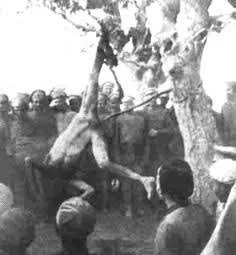The capture of brave Russian officer Rosinski
This is a shocking image and I apologize in advance for sharing it, but here’s one that truly got to me… in Belarus, 1918, after WWI had already ended, the brave Russian officer Rosinski was captured by the Bolsheviks.
The Bolsheviks tortured the captain, likely to get information out of the man, which he bravely refused to give. After that, they simply continued with the torture out of some sick sense of innate cruelty. He was ‘the enemy’ and he was at their mercy, so they brutally murdered their captive.
The brave captain was emasculated. And anally impaled on a tree branch. All this while still alive.
Alfred Savoir, the man who published the picture and was an eye witness to the death of the brave military officer, described "M. B.", who ordered this atrocity, thus:
I knew him not long ago; he was a charming teenager with an ironic wit and joker. He was rubbed with French culture, he admired the novels of Barres and he quoted willingly poets that I did not know quite. He was also a great dancer, a great flirteur and a good bridger. He often came to Paris, and he amused himself.
Today, this bourgeois benevolent and skeptical, this happy boy is impaling people. Understand who can!
This is a perfect example of just how cruel people can get. And also, its a perfect example of the very worst treatment, torture and humiliation a human being can be forced to endure.
What shocked Savoir the most when seeing the scene, wasn’t just the act of cruelty itself, but the utter indifference of the crowd.
Basically, the Communist soldiers overseeing the brutal torture of the prisoner of war in their hands, had seen similar horrendous tortures taking place before their very eyes. Rosinski, chillingly enough, wasn’t even the first, or the worst of their victims.
The hisyory of Soviet westward offensive of 1918–1919
The Soviet westward offensive of 1918–1919 was part of the campaign by the Russian Soviet Federative Socialist Republic into areas abandoned by the Ober Ost garrisons that were being withdrawn to Germany following that country's defeat in World War I.
The initially successful offensive against the Republic of Estonia ignited the Estonian War of Independence which ended with the Soviet recognition of Estonia.
The war against Republics of Latvia and Lithuania was more successful for the Soviets, and resulted in the Latvian Socialist Soviet Republic and Lithuanian Soviet Socialist Republics being established. In Belarus, the Belarusian People's Republic was conquered and the Socialist Soviet Republic of Byelorussia proclaimed.
The campaign eventually bogged down and led to the Estonian Pskov Offensive, the White Russian Petrograd Offensives, the Lithuanian–Soviet War, the Latvian War of Independence, continuation of the Ukrainian–Soviet War and the start of the Polish-Soviet War.
The Soviet westward offensive of 1918–1919 was part of the campaign by the Russian Soviet Federative Socialist Republic into areas abandoned by the Ober Ost garrisons that were being withdrawn to Germany following that country's defeat in World War I.
The initially successful offensive against the Republic of Estonia ignited the Estonian War of Independence which ended with the Soviet recognition of Estonia.
The war against Republics of Latvia and Lithuania was more successful for the Soviets, and resulted in the Latvian Socialist Soviet Republic and Lithuanian Soviet Socialist Republics being established.
In Belarus, the Belarusian People's Republic was conquered and the Socialist Soviet Republic of Byelorussia proclaimed.
The campaign eventually bogged down and led to the Estonian Pskov Offensive, the White Russian Petrograd Offensives, the Lithuanian–Soviet War, the Latvian War of Independence, continuation of the Ukrainian–Soviet War and the start of the Polish-Soviet War.
After signing the Treaty of Brest-Litovsk, Bolshevik Russia lost the European lands it annexed in the 18th and 19th centuries.
Most of today's Poland, Belarus, Ukraine and the Baltic states were granted to the government of Germany, which in turn decided to grant these states limited independence as buffer states.
However, the German defeat on the Western Front and the internal dissolution of Austria-Hungary made the plans for the creation of Mitteleuropa obsolete.
In November and December, the German army started a retreat westwards. Demoralised officers and mutinous soldiers abandoned their garrisons en masse and returned home.
The areas abandoned by the Central Powers became a field of conflict between local puppet governments created by Germany as part of its plans, local nationalist governments that sprung up after the withdrawal of the German forces, Poland, and the Bolsheviks wanting to incorporate these areas into Soviet Russia.
Belarusian, Estonian, Latvian, Lithuanian, Ukrainian and even Cossack national governments were formed. Internal power struggles prevented any of the governments in Belarus from gaining lasting power.
In Ukraine the situation was even more complex, with an ongoing conflict between Nestor Makhno's anarchists, communists, the White Movement, various governments of Ukraine and the reborn Polish Army.
The entire region abandoned by the German forces became a gigantic free-for-all theatre, where dozens of factions competed for power.
The Bolsheviks were also implementing a new strategy, "Revolution from abroad" ( revolution from the outside), based on an assumption that revolutionary masses desire revolution but are unable to carry it out without help from more organized and advanced Bolsheviks.
Hence, as Leon Trotsky remarked, the revolution should be "brought on the bayonets" (of the Red Army), as "through Kiev leads the straight route for uniting with the Austro-Hungarian revolution, just as through Pskov and Vilnius goes the way for uniting with the German revolution.
Offensive on all fronts! Offensive on the west front, offensive on the south front, offensive on the all revolutionary fronts!". The concept was developed in 1918 but officially published under that name first in 1920



Comments
Post a Comment
We can do better!